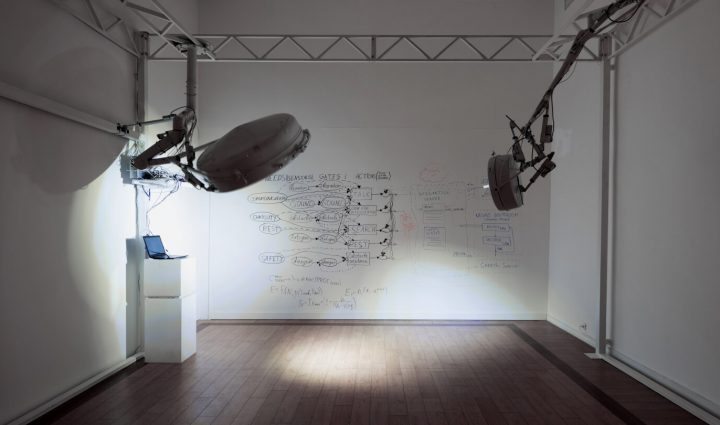Artistic effects of nature elements technic transformation
(aesthetic data)
David Bowen invents mechanisms and try to give them their own will. His robots react to the wind, light, behavior of houseflies and as a result they create drawings and compositions. They are trying to imitate the natural form, system or function.
The artist likes to observe this processes “how mechanical systems, motors and micro-controllers behave so unpredictably while plants and animals do with such a mechanical certainty”. There are three robotic installations, videos and drawings created by robots at the exhibition.
This installation produces drawings based on the subtle movements of houseflies. When flies enter a small chamber sensors detect their movements. A micro-controller articulates a drawing arm in real time based on the fly’s movements. When a fly is no longer detected in the chamber the paper scrolls over and the device waits until a new fly enters the chamber to begin another drawing.

TELE-PRESENT WIND
David Bowen (USA)
LABORATORIA Art&Science Space, Moscow, 2010
Fly drawing device, 2007
aluminum, plastic, electronics, houseflies, paper, crayon
photo: LABORATORIA
TELE-PRESENT WIND
David Bowen (USA)
LABORATORIA Art&Science Space, Moscow, 2010
Fly drawing device, 2007
aluminum, plastic, electronics, houseflies, paper, crayon
photo: LABORATORIA
TELE-PRESENT WIND
David Bowen (USA)
LABORATORIA Art&Science Space, Moscow, 2010
Fly drawing device, 2007
aluminum, plastic, electronics, houseflies, paper, crayon
photo: LABORATORIA
Daria Parkhomenko, David Bowen
LABORATORIA Art&Science Space, Moscow, 2010
photo: LABORATORIA
TELE-PRESENT WIND
David Bowen (USA)
LABORATORIA Art&Science Space, Moscow, 2010
Fly drawing device, 2007
aluminum, plastic, electronics, houseflies, paper, crayon
photo: LABORATORIA
TELE-PRESENT WIND
David Bowen (USA)
LABORATORIA Art&Science Space, Moscow, 2010
Fly drawing device, 2007
aluminum, plastic, electronics, houseflies, paper, crayon
photo: LABORATORIA
This installation consists of a series of 21 x/y tilting devices connected to thin dried plant stems installed in the gallery and a dried plant stems connected to an accelerometer installed outdoors in the artist native town Duluth (Minnesota, USA). When the wind blows it causes the stem outside to sway. The accelerometer detects this movement transmitting it in real-time to Moscow by internet to the grouping of devices in the gallery. Therefore the stalks in LABORATORIA move by the wind in Minnesota.

TELE-PRESENT WIND
David Bowen (USA)
LABORATORIA Art&Science Space, Moscow, 2010
aluminum, plastic, electronics, plants
photo: Alan Vouba
TELE-PRESENT WIND
David Bowen (USA)
LABORATORIA Art&Science Space, Moscow, 2010
aluminum, plastic, electronics, plants
photo: Valery Ledenev
TELE-PRESENT WIND
David Bowen (USA)
LABORATORIA Art&Science Space, Moscow, 2010
aluminum, plastic, electronics, plants
photo: Ignat Solovei
Daria Parkhomenko, David Bowen
LABORATORIA Art&Science Space, Moscow, 2010
Photo: Ignat Solovei
TELE-PRESENT WIND
David Bowen (USA)
LABORATORIA Art&Science Space, Moscow, 2010
aluminum, plastic, electronics, plants
photo: Dmitry Kawarga
Artist strives to create the most autonomous mechanism. Small robot which is solar powered is seeking for the most intensive source of light. As the robot moves from light to light a small piece of charcoal tracks its journey. Lights are connected to timers and arranged in various patterns causing the robot to create different compositions.

TELE-PRESENT WIND
David Bowen (USA)
LABORATORIA Art&Science Space, Moscow, 2010
Phototropic Drawing Device, 2003
electronics, charcoal, paper
photo: Alan Vouba
TELE-PRESENT WIND
David Bowen (USA)
LABORATORIA Art&Science Space, Moscow, 2010
Phototropic Drawing Device, 2003
electronics, charcoal, paper
photo: Alan Vouba
TELE-PRESENT WIND
David Bowen (USA)
LABORATORIA Art&Science Space, Moscow, 2010
Phototropic Drawing Device, 2003
electronics, charcoal, paper
photo: Alan Vouba
TELE-PRESENT WIND
David Bowen (USA)
LABORATORIA Art&Science Space, Moscow, 2010
Phototropic Drawing Device, 2003
electronics, charcoal, paper
photo: Valery Ledenev
TELE-PRESENT WIND
David Bowen (USA)
LABORATORIA Art&Science Space, Moscow, 2010
Phototropic Drawing Device, 2003
electronics, charcoal, paper
photo: Ignat Solovei
TELE-PRESENT WIND
David Bowen (USA)
LABORATORIA Art&Science Space, Moscow, 2010
Phototropic Drawing Device, 2003
electronics, charcoal, paper
photo: LABORATORIA
This system provides light and food in the form of hydroponic solution for the plant. The plant reacts to the device by growing. The device in-turn reacts to the plant by producing a rasterized inkjet drawing of the plant every twenty-four hours. When the drawing is funished the system scrolls the roll of paper approximately four inches so a new drawing can be produced during the next cycle. This system is allowed to run indefinitely and the final outcome is not predetermined.
Visitors could see and investigate not only the robots behavior but also the fruits of their creativity. The drawings created by a team of house flies and the “light-hunter” robot became a part of the exhibition.






